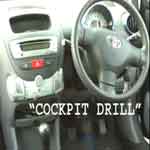Learn to Drive | First Driving Lesson with Your Teen
by: Anne Marie Hayes
A learner’s permit means your teen can start learning how to drive a car – not driving a car. The difference is – they need some time behind the wheel in a deserted parking lot, before they’re ready to actually start driving a car on the streets. So no matter how much they beg and plead, don’t let them drive home from the DMV office the day they pass their test. They aren’t prepared and it’s dangerous. It also teaches them to take a cavalier attitude about the very serious activity of learning how to drive a car.
More teens die in car crashes every year than from illness, street violence or drugs – combined! And – tragically – 99% of those crashes are completely preventable. So when you start your driving lessons, keep your eye on the real prize – keeping your teen alive. The decisions you make now will have a big impact on how they drive in the future and could save their life. Start them off right learning how to drive a car safely ansd responsibly.
A good driving school is a great start, but most driving schools provide less than 8 hours practice driving a car. Experts agree teens need at least 100 hours practice when they learn to drive to develop the reflexive driving skills they’ll need when something unexpected happens on the road. (And experienced drivers know – unexpected things happen every day.)

11 Things Every Driver Should Do Before Starting the Car:
Before you get in the vehicle:
1. Open the hood and check the windshield washer fluid. If it’s low, fill it up. (You never know when mud will splash or something else will obscure your vision.) Check the rear washer fluid too.
2. Walk around the car. Make sure there is nothing behind the vehicle or in the path you’ll be taking. Every day, in the United States, a child dies because someone accidentally backed over them.
Walking around the vehicle also gives the driver an opportunity to check for any damage to the vehicle. If someone scratched your car, you need to be able to tell the insurance company where it happened.
After you get in the vehicle:
3. Check your gas gauge. If it’s near the quarter tank mark, make sure you fill it up soon. Developing this habit will keep you from getting stranded by running out of gas.
4. Adjust your seat. You need to be high enough to see clearly and close enough to use the accelerator and brake. Your chest should be at least 10 inches away from the steering wheel to protect you from the airbag.
5. Adjust your mirrors.
6. Adjust your headrest. It should be squarely behind your head and could prevent you from getting whiplash if you’re involved in a crash.
7. Adjust your steering wheel.
8. Turn off your cell phone and the radio. You need to be able to hear your coach and stay focused on the road.
9. Secure any loose objects. If you stop suddenly, a loose pen can become a dart.
10. Buckle your seat belt and make sure everyone else in the car is buckled up too.
11. Lock the doors if they don’t lock automatically.
For more tips on learning how to drive a car safely, check out the “Video Library – Driving Lesson 1: SP”





One thought on “How to Drive a Car | First Driving Lesson with Your Teen”
Thanks for your comment. Of course, the best thing is not to drink and drive so the penalty will never be applied. 🙂